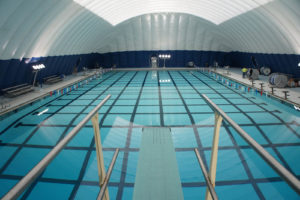
Advances in materials and technology mean advantages for air-supported fabric structures in durability and sustainability.
In May 2009, the Dallas Cowboys’ practice facility collapsed under a freak microburst of 60mph winds, injuring a dozen people and leaving at least one person partially paralyzed. It has taken the industry years to overcome the impact of this event (the forensic investigations determined that the cause was frame failure, not fabric failure), a situation that unfairly tars the entire air-supported structure industry by association.
Despite this setback, the past five years have seen steady improvement in sales and the gradual education of clients (as well as architects) on the value of air-supported structures, in part because of proven durability of materials and increased energy efficiency in the design of cladding systems. Often made up of an assembly of flexible composites, laminations and reinforced fabrics, these materials “more than adequately provide the strength necessary for huge open [space] structures,” says Lowell Duncan, structure membrane manager for Verseidag Seemee US Inc., Randolph, N.J. “Unfortunately, a few highly publicized dome failures have led many clients to assume that these types of structures are not safe. In almost every case of failure, it was a design flaw and not a material flaw.” Duncan points out there are many 20- to 25-year-old air-supported structures that are still in operation.
Air-supported structures can be found in applications that cover the gamut, including: the expected tennis courts and golf driving ranges as well as multi-sport gym and recreational centers, swimming pools, hockey and ice rinks, basketball arenas, paintball buildings, vehicle storage and airplane hangars, agricultural facilities, greenhouses, bulk storage, warehouses and construction sites. One application not recommended for air structures, says Steve Flanagan, CEO of Yeadon Fabric Domes LLC, Minneapolis, Minn., is equine arenas or animal parks. “We have found over the years that animals are too sensitive to the pressure change of a dome and will not enter it,” he says.
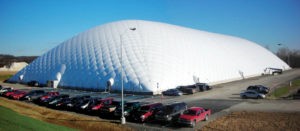
Photo: Big Span Structures
Proof of performance
The proven track record of air structures and the current economics of most types of construction are leading many clients to reconsider the fabric air-supported structure for certain applications, such as indoor field sports facilities. With increasing costs associated with sports facilities, it’s not surprising that air structures are finding favor due to their lower costs. This is especially true in suburban settings where one community is pitted against another, each city feeling the pressure to build expensive arenas, sports complexes or sports-related community centers. A recent story in the Minneapolis StarTribune (“Suburban Splurges: A Race to Build Big,” May 10, 2015) highlighted the challenge that municipalities face when considering sports facility funding. Comparing the costs of several new or newly proposed recreational facilities, the paper found that the communities increasingly were confronted with soaring debt burden for facilities that might not get used to capacity in the face of declining populations—yet they felt the urgency to build nevertheless. Air-supported fabric facilities were the least expensive option in the StarTribune survey. “Twin Cities suburbs are in the midst of a major boom in recreational facilities—an amenities arms race in which each is keenly conscious of what other cities are cooking up … Driving the building boom are a number of factors, including a desire to attract young and more affluent families.”
Critics argue this approach to development may be wrong, however. “The boom in sports facilities is the latest version of a flawed strategy by cities—‘building bling to accelerate growth,’“says Charles Marohn, president of Strong Towns, a nonprofit organization that works to help cities and towns become healthier financially and socially. According to the paper, the boom is taking place amid an historic population shift. “The year 2015 marks the first time when all five purely suburban counties [in the Twin Cities metropolitan area] are facing projected drops in the number of children.”
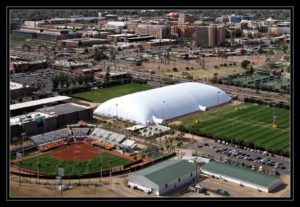
Photo: Yeadon Fabric Domes
Driving new markets
Countering this trend of decreasing suburban population (a related trend can also be seen in the dramatic decommissioning of municipal golf courses) is the increase in the use of sheltered sports facilities for educational institutions, both public and private, especially for sports facilities at colleges and universities. “Local governments are getting more involved with helping increase participation in healthy activities for children,” says Ian McCormick, vice president for sales and marketing for The Farley Group, based in Puslinch, Ont., Canada. “With the increased energy efficiency of air-supported structures I believe we’ll see a steady growth in indoor field sport facilities.”
“Most of the improvements in recent years that have permitted us to place our domes have been because of new education codes that allow air structures to be installed on school grounds,” says Flanagan. “Schools find the domes the best price-per-square-foot of facility available. The beauty of an air structure is that an educational organization can take an existing track or field, and in two days or up to a short week, put up a protective structure.”
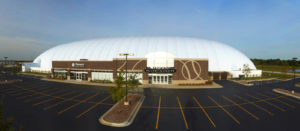
Ongoing challenges
It’s an attractive proposition: no longer do academic administrators have to search for available land nearby—often at a premium if the educational institution is located in urban or suburban settings that are increasingly built up. The main challenge typically comes from building codes. “It has been a long process of educating code officials and administrators,” says Flanagan. “Structures like these used to have 12- to 15-year warranties, and now because of improved material specifications and performances, warranties are 18 to 20 years, which make them highly desirable for school budgets. The materials alone have 25- to 30-year warranties, so we can offer more options.”
Code issues were a main concern for all manufacturers interviewed for this article. “The fact that air-supported is typically an unusual project for code officials,” says McCormick, “means that there’s always a learning curve when going through the approval process. An air-supported structure also always needs special attention with regard to surrounding buildings (they should be at least 10 feet away to allow for snow to shed off).”
Not only code officials, but manufacturers as well, feel clients need to learn more about this special type of structure if the industry is to grow at a faster rate. Key to this, says Matt Polizzi, director of marketing and inside sales, Arizon Companies, St. Louis, Mo., is “educating the general public and the towns and municipalities that each of our domes is built to the International Building Code for their area. Today’s air structures are substantive and are meant to last several decades.”
Despite many improvements in materials, performance and testing standards, it appears that local building codes will be an issue for some years to come. “An air-supported structure can meet all of the building codes around the world,” says German Buitrago, vice president for the Pressurized Buildings Division of Big Span Structures LLC, Hernando, Fla. “However, there are some states that require energy conservation codes that are very difficult to achieve with these types of structures, due to the fact that the energy building codes are being written for conventional type structures such as steel and concrete buildings.”
Perhaps the most common challenge faced is flammability testing. “The materials must pass NFPA 701 requirements for flame,” says Duncan. “But we are also seeing more clients asking for ASTM E84 certification, which is a smoke density test.” Flanagan has also encountered code requirements that call for sprinklers inside buildings (“For a building that can’t burn!” he says) as if the fabric were comparable to other building materials that may combust. “For temporary structures, this is not a problem because the code does not come into play, but it does impact permanent structures,” says Flanagan. Additional code issues include safety compliances, which Flanagan says begin to require grade beams to counter uplift in high wind zones. “This just adds cost, from 20 to 25 percent more to build.”
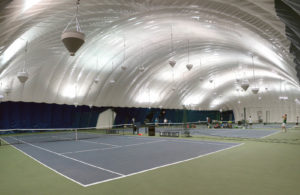
Innovation and advantage
Despite new requirements that add manufacturing costs, many in the industry believe that air-supported structures are still a bargain for clients looking to add onto a facility or create a new building with large space requirements. “I would say that these [buildings] are one-third the cost of a traditional brick building” of comparable size, says Christopher M. Reidy, sales manager for Hiraoka USA Inc. in Carlisle, Pa., the North American office of Hiraoka & Co. Ltd., a Japanese manufacturer of polymer-coated fabrics. “With translucent fabrics, another cost savings for domes comes with the benefit of natural light. Air domes let more sunlight pass into the structure, helping clients save up to 15 percent on electric costs because of a diminished need to use the lighting,” adds Reidy.
“Fabric air structures today are substantially more energy efficient then in the past,” says Polizzi. “With sophisticated control systems, custom-built mechanical units, LED lights and more durable architectural fabrics, our air structures are redefining traditional building.” Duncan agrees that improved materials have helped the overall picture: “We feel it is important to continue development of better topcoat systems that will offer superior UV resistance, hence longer life, while at the same time make fabrication no more difficult or complicated than it is today.” Flanagan echoes that outlook. “We’ve definitely seen improvement in the protective coatings of fabric, such as PVDF and antimicrobial TiO2. The ‘big knock’ against air structures used to be longevity. These new materials extend the warranties to being comparable with bricks-and-mortar buildings, and maintenance is minimal with self-cleaning capabilities.” Buitrago reinforces the consensus that more energy-efficient fabrics offer both the strength and desired energy ratings to provide clients with an environmentally friendly product.
What can we expect on the horizon? More of the same types of innovations that have come within the past 10 years, according to Polizzi: “The facilities we create today on the whole are much larger than in the past. It’s now common to construct 50K, 80K and 100K square-foot facilities. With advancements in the product and expected longevity, the size of facilities has inflated,” he quips.
Air-supported fabric structures, despite some unearned bad press on fabric as a building material, are still providing an economical, energy-efficient and sustainable alternative to traditional structures, in both temporary and permanent applications. The benefits of inflation seem to be regaining lost ground.
Bruce N. Wright, AIA, a licensed architect, is a media consultant to architects, engineers and designers, and writes frequently about fabric-based design.
 TEXTILES.ORG
TEXTILES.ORG



2 responses to “Air support”